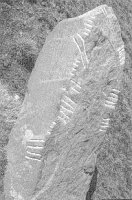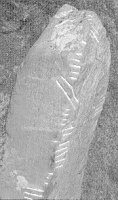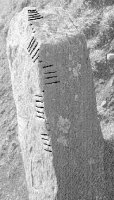According to Macalister, CIIC, the stone, "sometimes referred to as the Bracklaghboy stone .. standing on the top of a low mound, (is) apparently an artificial tumulus". It has to be noted, however, that the mound (whether artificial or not) forms the top of a hill (431 ft. according to the O.S. map) which surpasses every other height on the Western side of Island lake and which offers an excellent sight around, so that the stone could as well have served as a land mark. Nearby are the ruins of a castle.
Size according to Macalister, CIIC: 5'3" x 1'10" x 1'1".
The stone is not included in Macalister, Epig..
CUNALEGI AVI QUNACANOS
"The inscription .. is injured by wear and chipping. The reading is, however, certain .. although AVI (except the distal ends of the V) and parts of some other scores are chipped away ... The space does not confirm Rhys's contention that the second word should be AVE, not AVI, to agree with the nominative CUNALEGI (= -LE[N]GIS): there is a length of 5" vacant, whereas E would require only 4"."
CUNALEGI [A](V)[I] QUNACANOS
This is an inscription of the type "(the stone) of A, grandson of B". - Because of the QU- written instead of CU- the inscription can be dated into the end of the 5th century. - [p. 184 f. s.v. QUNACANOS:] The unusual writing of QUNA- instead of CUNA- witnesses to the fact that kwu- and ku- had already become mixed up; but there might have been an analogical influence of the nominative *kw¬. - The second element is connected with canaid "to sing", the whole name meaning something like "the one praising the wolf". Cp. O.Ir. Fa‚l-char "the one loving the wolf".
Reading Gippert (5.4.1996):
 Dexter angle up -
Dexter angle up -  top left -
top left -  top right - sinister angle down:
top right - sinister angle down:
CUNALEGI A[V ] QUNACANOS
îíäêéâèåãðåäæâ[é ]æîíäêéâîíâêéãêè
ëëëëâââçççççâççââââïïâââââæâ[ççç ](æë)ëëëëâââçççççâëëëëâçççççââçççç
Q1 might well be secondary, given that it is much shorter than the other strokes of this letter; cp. figs. 9 and 10. If not, it can be taken as a mere scribal error; at least, no linguistic conclusions can be drawn from its existence, e.g. as to the dating of the inscription into a period when the difference between C = /k/ and Q = /kw/ no longer existed. Of the V, even the distal ends are hardly conceivable, and there is hardly room enough for restituting an I on the  sinister part of the top.
sinister part of the top.
Additional literature:
- Rhys, JRSAI 28, 1898, 396;
- Cochrane, JRSAI 28, 1898, 400;
- Rhys, PRIA 22, 1899, 179.
Last changes of this record: 14.04.97
Copyright Jost Gippert, Frankfurt a/M 1996. No parts of this document may be republished in any form without prior permission by the copyright holder.  Dexter angle up -
Dexter angle up -  top left -
top left -  top right - sinister angle down:
top right - sinister angle down: sinister part of the top.
sinister part of the top.








